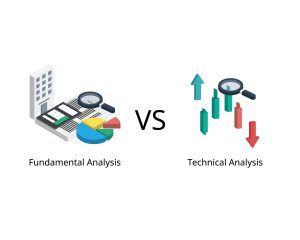
- Logo
- Ticker
- Company Name
- Exchange
- Previous close
Fundamental Analysis vs Technical Analysis

Fundamental Analysis vs Technical Analysis

When it comes to analyzing the market or understanding companies, two primary methods often take center stage: Fundamental Analysis (FA) and Technical Analysis (TA). While both have their uses, they serve different purposes and cater to distinct strategies.
This article explores the differences between Fundamental Analysis and Technical Analysis, their strengths and limitations, and why FA is often preferred for those focusing on long-term goals.
What is Fundamental Analysis?
Fundamental Analysis examines a company’s intrinsic value by analyzing both quantitative and qualitative factors. The focus is on understanding a company’s overall health, sustainability, and growth potential.
Key Focus Areas of FA:
- Financial Performance: Examines metrics like revenue, profit margins, and debt levels.
- Qualitative Factors: Includes leadership quality, brand strength, innovation, and competitive positioning.
- Market and Economic Trends: Considers industry performance and macroeconomic conditions affecting the company.
The ultimate goal of FA is to determine whether a company is undervalued or overvalued based on its intrinsic value.
What is Technical Analysis?
Technical Analysis focuses on studying historical price movements and trading volume to predict future price trends. Unlike FA, TA does not evaluate the intrinsic value of a company but instead looks for patterns in market data.
Key Focus Areas of TA:
- Price Patterns: Analyzes candlestick charts, trendlines, and support/resistance levels.
- Indicators: Uses tools like Moving Averages, Bollinger Bands, and Relative Strength Index (RSI).
- Market Sentiment: Tracks momentum and volatility to identify potential opportunities.
TA is often used by those who prioritize short-term trading strategies over long-term evaluation.
Why Fundamental Analysis is Often Preferred
- Focuses on Long-Term Value
FA prioritizes understanding a company’s true worth by analyzing its financial health and growth potential. This long-term approach helps avoid reacting to short-term price fluctuations, instead focusing on sustainable success.
Example: Companies like Amazon and Apple rewarded those who invested based on their underlying value rather than reacting to short-term market changes.
- Relies on Business Fundamentals, Not Speculation
FA evaluates tangible aspects of a company, such as revenue growth, profitability, and leadership quality. This reduces reliance on speculative patterns or market sentiment that often drive TA.
- Encourages Discipline and Patience
While TA often requires rapid decision-making, which can lead to impulsive behavior, FA promotes a structured, research-driven approach. This method aligns with long-term goals and reduces the risk of emotional trading.
- Minimizes Trading Costs and Risks
TA’s frequent trades can lead to high transaction fees and tax implications. In contrast, FA focuses on buy-and-hold strategies, reducing costs and allowing compounding to maximize returns.
- Offers a Holistic View
FA goes beyond numbers, incorporating qualitative factors like management effectiveness, competitive advantages, and innovation potential. These insights often play a critical role in determining a company’s long-term success.
Limitations of Technical Analysis
While TA can be useful for short-term trading, it has several limitations:
- Ignores Intrinsic Value: TA does not account for a company’s financial health or business fundamentals.
- Relies on Patterns: Assumes historical trends will repeat, which isn’t always the case in unpredictable markets.
- Short-Term Focus: Best suited for day trading or short-term speculation, not for evaluating sustainable growth.
- Emotionally Driven: The fast-paced nature of TA can lead to impulsive decisions influenced by fear or greed.
Key Takeaways
- Fundamental Analysis: Focuses on intrinsic value, long-term growth, and business fundamentals.
- Technical Analysis: Relies on historical price data and patterns, prioritizing short-term trends.
- FA provides a more reliable, disciplined approach for those looking to understand a company’s sustainability and value.
With Invetso’s frameworks, you’ll gain access to structured tools that emphasize qualitative analysis, helping you uncover the intangible factors that drive long-term success and offering clarity for your research.
🎯 Sign up for free today to unlock qualitative insights with Invetso for a complete understanding of your favorite companies.
Disclaimer: Invetso is not a financial advisor, and all information is provided solely for informational purposes.
You can continue reading
Fundamental Analysis vs Technical Analysis

Fundamental Analysis vs Technical Analysis

When it comes to analyzing the market or understanding companies, two primary methods often take center stage: Fundamental Analysis (FA) and Technical Analysis (TA). While both have their uses, they serve different purposes and cater to distinct strategies.
This article explores the differences between Fundamental Analysis and Technical Analysis, their strengths and limitations, and why FA is often preferred for those focusing on long-term goals.
What is Fundamental Analysis?
Fundamental Analysis examines a company’s intrinsic value by analyzing both quantitative and qualitative factors. The focus is on understanding a company’s overall health, sustainability, and growth potential.
Key Focus Areas of FA:
- Financial Performance: Examines metrics like revenue, profit margins, and debt levels.
- Qualitative Factors: Includes leadership quality, brand strength, innovation, and competitive positioning.
- Market and Economic Trends: Considers industry performance and macroeconomic conditions affecting the company.
The ultimate goal of FA is to determine whether a company is undervalued or overvalued based on its intrinsic value.
What is Technical Analysis?
Technical Analysis focuses on studying historical price movements and trading volume to predict future price trends. Unlike FA, TA does not evaluate the intrinsic value of a company but instead looks for patterns in market data.
Key Focus Areas of TA:
- Price Patterns: Analyzes candlestick charts, trendlines, and support/resistance levels.
- Indicators: Uses tools like Moving Averages, Bollinger Bands, and Relative Strength Index (RSI).
- Market Sentiment: Tracks momentum and volatility to identify potential opportunities.
TA is often used by those who prioritize short-term trading strategies over long-term evaluation.
Why Fundamental Analysis is Often Preferred
- Focuses on Long-Term Value
FA prioritizes understanding a company’s true worth by analyzing its financial health and growth potential. This long-term approach helps avoid reacting to short-term price fluctuations, instead focusing on sustainable success.
Example: Companies like Amazon and Apple rewarded those who invested based on their underlying value rather than reacting to short-term market changes.
- Relies on Business Fundamentals, Not Speculation
FA evaluates tangible aspects of a company, such as revenue growth, profitability, and leadership quality. This reduces reliance on speculative patterns or market sentiment that often drive TA.
- Encourages Discipline and Patience
While TA often requires rapid decision-making, which can lead to impulsive behavior, FA promotes a structured, research-driven approach. This method aligns with long-term goals and reduces the risk of emotional trading.
- Minimizes Trading Costs and Risks
TA’s frequent trades can lead to high transaction fees and tax implications. In contrast, FA focuses on buy-and-hold strategies, reducing costs and allowing compounding to maximize returns.
- Offers a Holistic View
FA goes beyond numbers, incorporating qualitative factors like management effectiveness, competitive advantages, and innovation potential. These insights often play a critical role in determining a company’s long-term success.
Limitations of Technical Analysis
While TA can be useful for short-term trading, it has several limitations:
- Ignores Intrinsic Value: TA does not account for a company’s financial health or business fundamentals.
- Relies on Patterns: Assumes historical trends will repeat, which isn’t always the case in unpredictable markets.
- Short-Term Focus: Best suited for day trading or short-term speculation, not for evaluating sustainable growth.
- Emotionally Driven: The fast-paced nature of TA can lead to impulsive decisions influenced by fear or greed.
Key Takeaways
- Fundamental Analysis: Focuses on intrinsic value, long-term growth, and business fundamentals.
- Technical Analysis: Relies on historical price data and patterns, prioritizing short-term trends.
- FA provides a more reliable, disciplined approach for those looking to understand a company’s sustainability and value.
With Invetso’s frameworks, you’ll gain access to structured tools that emphasize qualitative analysis, helping you uncover the intangible factors that drive long-term success and offering clarity for your research.
🎯 Sign up for free today to unlock qualitative insights with Invetso for a complete understanding of your favorite companies.
Disclaimer: Invetso is not a financial advisor, and all information is provided solely for informational purposes.
You can continue reading
Unlock exclusive Perks
Be part of a select group and enjoy exclusive benefits reserved only for our Premium members.

- Logo
- Ticker
- Company Name
- Exchange
- Previous close
Updated: November 24, 2025
We have not found the stock you are looking for


